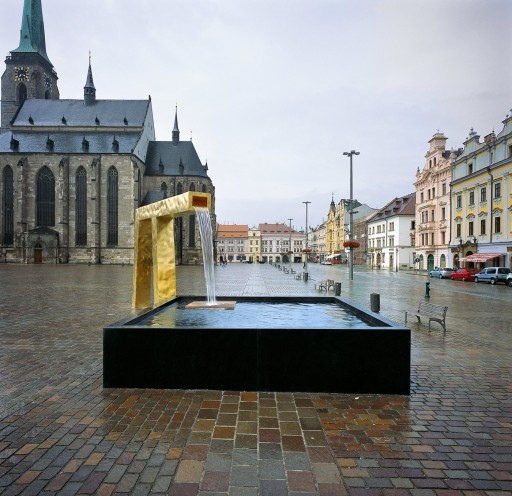
The gilded fountains have been in the Pilsen square for ten years
 |
"Over the past ten years, the fountains have garnered a range of positive and negative evaluations from residents and visitors to Plzeň. However, for tourists, they have overwhelmingly become a sought-after destination for admiration and photography. I think that Plzeň residents have mostly gotten used to the fountains and have integrated them into their lives, although of course, there are still many opponents of this city-typical work," said Mayor Martin Baxa (ODS) to ČTK. Císler has received several architectural awards for his fountains.
The fountains returned to the vacant corners of the square after 125 years. They were the final touch after the reconstruction and paving of the square. In the fourth corner stands a plague column. The installation of the spouts, the tallest of which measures up to four meters, cost the municipality nearly 27 million crowns. Císler's design was selected by a professional jury in an architectural competition in 2005, among 42 proposals. Politicians initially rejected the fountains and only approved their construction after modifications to size, shape, and surface.
Císler would change nothing about the fountains even today. "I am proud of this my first work. It was the first thing I did after finishing school, even though a relatively long time passed between the competition and their realization, and in the meantime, I built some buildings," he told ČTK. "It is something that has become a part of the city's image. I have seen them countless times in connection with the presentation of Plzeň. It is one of the functions that the fountains are supposed to perform, and I believe they perform it excellently," he added.
The fountains spout water from spring to autumn, but maintenance must be done year-round. Due to scratches, for example, the city had to re-gild the fountains three times already. Approximately 720 grams of gold leaf in about seven different shades were used over an area of roughly 70 m² during the creation of the fountains.
From May 1 to October 31, city workers check the fountains once a day. They ensure the cleanliness of the water, wash the spouts and stone basins, and address minor faults, keeping the work functional and in impeccable condition, stated Ilona Pelíšková from the municipal organization Administration of Public Assets of the City of Plzeň. At the beginning of November, the water from the fountains is drained, and maintenance is performed before winter. During the time the water is drained, the fountains are checked once a week.
While in the first days after the launch, the fountains became targets for vandals, in recent months, guards have reported similar incidents rarely. "Earlier, drunk people or homeless individuals would bathe in the fountains; the police recorded cases where people fished for tossed coins with nets, scratched inscriptions into the fountains, or even washed clothes," said city police spokesperson Jana Pužmanová.
This spring, shortly after the launch of the Camel fountain, deep cracks appeared in the bottom of the monolithic basin made of black granite from China, through which water was leaking onto the sidewalk and reaching the electrical installations. Cracks in this basin had been repaired before as well. Due to the extent of the damage and based on expert assessments, the city plans to repair the basin by fitting it with a lead-lined tub, Pelíšková added.
The English translation is powered by AI tool. Switch to Czech to view the original text source.
1 comment
add comment
Subject
Author
Date
... No... vida!...
šakal
04.08.20 04:14
show all comments
Related articles
0
23.04.2025 | Plzeň fountains will come alive after winter, the city's annual cost for their operation is 700,000 CZK
1
19.07.2024 | Plzeň announced an architectural competition for the new layout of the Republic Square
0
25.04.2024 | Plzeň will announce an architectural competition for modifications to the central Republic Square
0
21.06.2022 | Mayor of Plzeň: The Greens in the square should be addressed by the new councilors
20
02.09.2010 | FOUNTAINS SWIRL CITY











